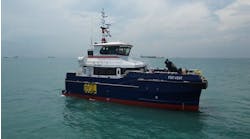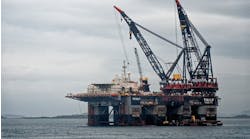Offshore wind roundup: Schroders Greencoat, Venterra, PD Ports, Heriot-Watt University and Reblade share latest project and technology updates
The following is a compilation of some of the latest offshore wind news, project updates and technology advances announced over the past month.
Ørsted divests 24.5% stake in offshore wind farm
Ørsted has farmed down a 24.5% interest in the West of Duddon Sands wind farm 14 km from the UK’s west coast to funds managed by Schroders Greencoat, according to a May 1 Ørsted news release.
Value of the transaction is about DKK4 billion ($669 million). Schroders Greencoat is already collaborating on four other North Sea wind farms: Walney, Burbo Bank Extension, Hornsea 1 and Borkum Riffgrund 1.
West of Duddon Sands, with a capacity of 389 MW, has been operating since 2014.
Venterra completes Celtic Sea metocean study
In Dublin, Venterra has completed a regional metocean characterization study for Ireland’s South Coast Designated Maritime Area Plan (SC-DMAP), commissioned by the Department of the Environment, Climate and Communications (DECC), according to an April 30 Venterra news release.
The results will support preparations for the country’s forthcoming Offshore Renewable Electricity Support Scheme (ORESS) Tonn Nua Offshore Wind Auction.
For its campaign, Venterra applied numerical modeling techniques and provided a 40-year hindcast dataset of metocean conditions across the SC-DMAP and its four Maritime Areas in the Celtic Sea offshore southern Ireland designated for offshore wind development.
The analysis assessed likely long-term operational and extreme conditions. Work included development and validation of site-specific hydrodynamic, wind and wave models; and the generation of spatial maps for metocean conditions.
One of the four maritime areas, the 900-MW potential Tonn Nua (Maritime Area A), will be developed by the winner of Ireland's second offshore wind auction later this year.
PD Ports to develop offshore wind manufacturing hub
In northeast England, PD Ports has revealed plans to develop the Teesport Offshore Gateway, which it claims could be one of the UK’s largest offshore wind manufacturing and installation hubs around the River Tees, according to an April 29 company news release.
This will open 180 acres for potential development of wide-ranging offshore manufacturing, assembly, marshalling and supply chain support services. The site, located within the Teesport industrial complex, will include a deepwater riverside quay up to 1 km long that will ensure unrestricted access to the North Sea, suited to both floating and fixed-bottom offshore wind developments.
Planning remains in the early phase and subject to a variation of existing deepwater berth development consents. PD Ports estimates the development cost at about £200 million ($267 million).
It is seeking engagement with the offshore wind sector, OEMs, developers, the UK government and industry specialists on how best to use the site as well as to jointly identify opportunities for collaboration and funding.
The site has secured planning and marine consents, subject to amendments, to extend an existing riverside berth to develop the 15.5-m deepwater mooring quay to accommodate all current and planned offshore installation vessels.
Heriot-Watt simulation tool predicts underwater landslides
In Edinburgh, Scotland, researchers at Heriot-Watt University have developed a simulation to predict potential underwater landslides caused by offshore wind turbines, according to a May 1 press release.
The technique is said to allow developers to assess seabed stability not only at the design stage but throughout a wind farm’s life, enabling more optimized placement of turbines with increased confidence in their long-term resilience.
Underwater landslides take place when sections of the seabed suddenly shift. This can affect the stability of wind turbines, notably in areas with soft seabed soils and gentle slopes.
Monopile foundations used with some turbines can contribute to seabed stress.
The new tool identifies potential landslide zones, combining soil mechanics theory with a shear strength reduction method to assess how the seabed holds together under stress.
Benjian Song, a PhD student at the university, said, “We tested our method on 3D models of the ocean floor, including real-world locations like Silver Pit, off the coast of Lincolnshire [eastern England]—a region with a history of submarine landslides.
“Our tool maps potential landslide zones and assesses how turbine foundations influence seabed conditions over time. Crucially, it also solves a major issue for existing models, which struggle to simulate multiple landslides occurring simultaneously."
Dr. Cathal Cummins said simulations of a monopile showed that they can create stress concentrations.
“We also found that increasing the diameter and depth of monopiles enhances overall slope stability, offering a potential design solution to mitigate risk," Dr. Cummins added. “Storms further weaken the seabed, and the dynamic loads transferred through monopiles can reduce soil strength. Our tool allows developers to factor in these effects and make decisions about wind farm resilience.”
Reblade launches wind farm decommissioning consultancy service
Glasgow, Scotland-headquartered Reblade, a specialist in turbine blades repurposing, introduced a wind farm decommissioning consultancy service on April 29.
The aim is to provide wind farm operators with comprehensive decommissioning support, from initial strategy development through implementation, and to help them take on the technical, environmental and regulatory challenges of wind farm end-of-life management.
The consultancy service (provided by project managers, planners and ecologists) includes site-specific decommissioning strategies, stakeholder management, regulatory compliance, landowner engagement, decommissioning work scopes, budget forecasts and methodology development.






